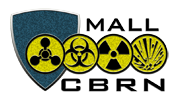Symbiosis of terrorism and radiological safety is one of the most challenging new threats.
There are more than 840 research reactors worldwide, many of which are located in large cities. These are not often properly protected as other critical infrastructure (CI) targets of our societies. Handling of sunken nuclear- and radiation-hazardous wastes in the world seas sets an additional challenge. For instance, seven nuclear-hazardous facilities sunken or submerged in the waters of the Arctic are currently known. Submarine B-159 sank in 2003 only about 60 kilometers from Murmansk and presents the greatest hazard to the environment. Submarine K-27, which sank in 1981, contains two reactors with liquid metal coolant containing highly enriched uranium, which could lead to mis-usage by terrorist and extremists.
European countries building new nuclear energy capacity such as Finland, Turkey, Hungary and Belarus. These are based on nuclear partnership with Russian technology. Belarussian NPP “Astravets” is a 2,400-megawatt-electric (MWe) plant, with two VVER-1200 reactors. It was built by Atomstroyexport, an affiliate of Russia’s state-owned Rosatom.
Finland is constructing an analogous nuclear power plant “Hanhikivi 1” AES-2006 designed by Rosatom which is based on same “VVER-technology”. Turkey signed an agreement in May 2010, that a subsidiary of Rosatom would build, own, and operate a power plant at Akkuyu comprising four 1,200 MW VVER units. Rosatom’s 12.5 billion euro project to build two Russian VVER 1200 reactors in Hungary could come online in 2026 and 2027 respectively. Rosatom’s international strategy BOO (Build, Own, Operate) concept means that Rosatom will build the nuclear power plant, provide the necessary technical know-how and provide the main funding, as well as continue to lead the construction of the power plant and, ultimately, operate its operations. As the European Commission states, “Russia is a key competitor in nuclear fuel production and offers integrated packages for investments in the whole nuclear chain. Therefore, particular attention should be paid to investments in new nuclear power plants to be built in the EU using non-EU technology.”(European Commission, 2014). This should also mean that EU starts building comprehensive security and safety strategy with the selected service provider, including comprehensive cyber safety.
During 2020, the creation of a technically modern, cost effective, and environmental friendly radioactive waste management system for disused radioactive sources of ionizing radiation treatment was established. Russia (RADON) has decades of experience in dealing with disused radioactive sources and radioactive waste materials at its facility. Long-term storage of disused radioactive sources in specialized storage containers allow transportation to the final disposal site when necessary. Specialized containers that do not require extraction of the disused radioactive sources minimize the possibility of losing control of the sources through loss or theft while providing opportunities for temporary storage and then final disposal of the radioactive waste. This is particularly important as emerging concern is prevention of access by terrorists to radioactive mobile sources, lost radioactive materials, and uncontrolled radioactive waste storage facilities.
During past years Europol has reported a steady increase in the number of individuals in concluded court proceedings for CBRN related terrorism activities. Verdicts for incidents concerned jihadist terrorists, mostly linked to ISIS are rapidly growing. At the same time the number of disrupted jihadist terrorist plots have increased. These included attempts to produce and deploy CBRN substances although most have been carried out using knives and firearms, predominantly on civilian targets. All plots relying on explosives have been disrupted. As to use of CBRN materials, Europol reported for instance plots in Paris to use black powder extract from pyrotechnics and possibly ricin, in Cologne and in Sardinia where the water supply of the Lebanese army would be poisoned. In addition, two Georgians were detained in 2018 in Kobuleti attempting to sell uranium. Meanwhile there has been steady increase of CBRN terrorism propaganda and related threats on sport halls, shopping malls, and ferries, all of which provide suitable locations for large attacks. As in previous years, intentions to use CBRN materials mainly by jihadists have increased. Finally, an ISIS-affiliated group launched a campaign titled Bio-Terror via Telegram promoting the use of biological weapons. EU is taking fast steps forward and several projects are now underway to protect public spaces.
Therefore, for instance, a Mall-CBRN project aims at creating a comprehensive program of prevention and response to CBRNe threats at shopping malls. Project started with a gap analysis in shopping mall security systems and identification of most likely scenarios of terrorist acts. At further stage the project will elaborate recommendation for prevention and response to CBRNe terrorist acts and comprehensive food safety/security mechanism. Consortium members and external experts involved in the project represent experienced specialists in the field of CBRN. Experts include, for example, representatives of LEAs, military institutes, security companies or high governmental organisations. The Mall-CBRN Project is aiming at creating prevention, response and consequence management mechanisms and interoperable capabilities, and practical recommendations for internal security services as well as algorithms of cooperation with services in cases of CBRN attacks.
Intergovernmental and governmental agencies, non-governmental organizations, and individuals that are involved in the handling or protection of nuclear material have a responsibility to contribute to increasing need of radiological and nuclear safety. Atomic Energy Agency (IAEA), Nuclear Safety and Espoo Conventions, Aarhus and Helsinki Water Conventions, organisations of the European Union and European Nuclear Safety Organisation (WENRA, ENSREG), the United Nations and other organisations such as the International Civil Defence Organisation (ICDO) and the Baltic Civil Defence Network should be involved. While protecting well-known nuclear storages, national critical nuclear assembles, and vital functions for radioactive material is very important, terrorists are often few steps ahead on the move searching for any types of radiological weapons or materials that can cause collective damage or deaths.
Dr Timo Hellenberg, CEO, Hellenberg International Ltd
Photo Ebunny Pixabay

